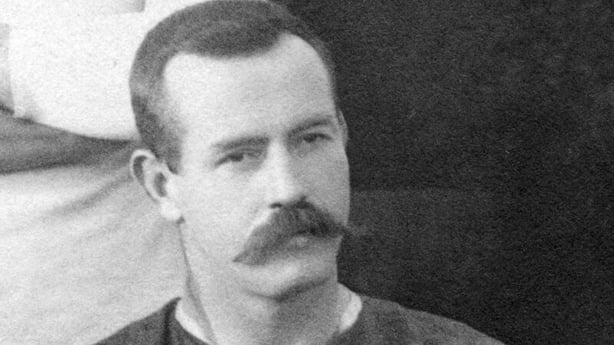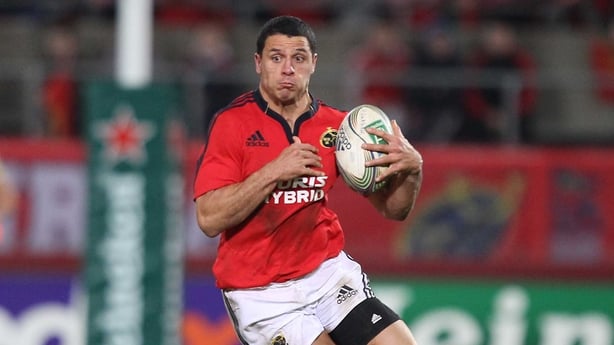While Ireland unfortunately fell at the quarter finals stage, the two competing finalists of New Zealand and South Africa have some interesting Irish connections in their formative years of playing rugby.
The connection is stronger in New Zealand. Many rugby fans are aware of Dave Gallaher, the legendary captain of the 1905 original All Blacks who was born in Donegal and led the first official New Zealand tour of the northern hemisphere.
The tour was incredibly successful for the newly nicknamed All Blacks. The team returned home to a resounding welcome and the 1905 tour left a lasting legacy on New Zealand rugby. The tour set the high standard for New Zealand rugby and gave the example of how rugby should be played.
Rugby in New Zealand became firmly established as the national sport and part of the national psyche. While Gallaher is the most well-known Irish connection the links are there from even earlier.
The first New Zealand rugby tour was a privately organised venture to New South Wales in 1884. New Zealand wore a blue shirt with gold fern and fielded a team which included two Irish born players, both forwards.
The Kerry born Timothy O'Connor who played for Auckland went on to become three time Australasian shot put champion, while the Otago speedster James O’Donnell from Kilkenny who remained in New South Wales after the tour with creditors chasing him for money back in New Zealand.
O’Donnell would play for New South Wales against the first British Lions touring team in 1888 and later became involved in local politics. His son John was later capped three times for the Wallabies in the 1920s. O'Connor would also play against the 1888 Lions, captaining Auckland to a famous win in the second of two clashes.
In the late 1880s another private enterprise was hatched by Joseph Warbrick. He wanted to send a team of Māori players to Britain and Ireland to play rugby matches. The team called themselves the New Zealand Natives even though many of the players that eventually travelled had no Māori blood. They arrived in England in September 1888 and played a gruelling schedule of 74 matches in less than six months. With the Māori influence in the team, they were the first team to perform a haka before matches. They were also the first New Zealand team to wear all black.
The star of the 1888-89 tour was Patrick Keogh. Keogh was born in Birmingham, England to Irish parents. He was the youngest son of Patrick Sr from Carlow and Ellen from Mayo. They moved to Dunedin on New Zealand’s south island when Patrick Jr was young.
Keogh developed into an accomplished rugby player and was seen as one of the best half back players in New Zealand.
As the Natives team were stuck for players, they asked Keogh to join due to his dark complexion. Keogh played 60 of the 74 games on the British and Irish leg of the tour and scored 34 tries. In between the county sides and club matches, they played three international matches, against Ireland, Wales, and England.
The first was against Ireland at Lansdowne Road on 01 December 1888. The NZ Natives had a comfortable win in which Keogh scored two tries and the Irish press were strong in their praise of him.

On kicking duties that day was Edward McCausland whose parents were from Armagh. McCausland as the kicker would end the tour as the highest point scorer. The Natives lost against Wales and England with the conduct of the Natives deemed ungentlemanly and created some controversy in English rugby circles. The Natives soon left for home without the ceremonial goodbye that would be expected of the time.
Although an exceptional talent and regarded as one of the best players of his day, Keogh was a controversial figure. At one point during the tour, he refused to play having been rejected for a loan of some money. They returned home via Australia playing a few games there.
Keogh was accused with some others of playing to intentionally lose for money but was cleared. In 1891, he was banned from rugby for admitting that he betted on rugby games. The ban was ended in 1895 but his career was over. Sadly for Keogh, he would die in a lunatic asylum in 1940 having spent 20 years in there due to mental illness.
The 1884 tour and 1888-89 tour laid the foundation for New Zealand rugby and the success of the Native tour had a significant impact on the development of rugby in New Zealand leading to the creation of the New Zealand Rugby Football Union in 1892 which in turn influenced the Dave Gallaher led tour in 1905.
Like a lot of rugby playing countries, schools became important in developing young players now interested in rugby. In New Zealand, the Marist order have a strong connection to rugby. The Marists are a French order but had a strong Irish presence, so much so that the first Marist school to open in New Zealand was St Patrick's, Wellington which opened in 1885 with the schools rugby team starting that same year. Many of the early teachers were from the Marist College in Dundalk. The Marist network in New Zealand have their tournaments and among the various trophies that can be won are the Spillane Cup, the Brennan Cup, and the Moran Cup.
There are many Marist Old Boys Club across New Zealand, one of the more notably ones from an Irish point of view is the Auckland club – Marist Brothers Old Boys. Formed in 1908, the club quickly became the club of the Catholic Irish in the city. Having joined the senior ranks of Auckland rugby in 1910, they would win the city championship in 1913 and Albert "Doolan" Downing and Jim "Buster" Barrett became the club’s first and second All Black’s around this time.

The club competes for the Gallacher Shield, the senior Auckland club trophy. In more recent times, the club has produced players like John Kirwan, Bernie McCahill and Dougie Howlett (above) who played for Munster.
In 1971 a club called Marist St.Pat’s formed in Wellington, the club was an amalgamation of Marist Club formed in 1918 and St Pat's Old Boys formed in 1926. Among the Marist St. Pats players to play for the All Blacks are John Fleming, Brian McGrattan, and more recently Victor Vito.
The All Black’s opponents in the final are their fierce rivals South Africa. While the Bok’s Irish connections aren’t as strong, there are a few links. South Africa is proud of its forward prowess, in particular dominance in the scrum and it was a South African player of Irish heritage who brought the scrum as we know it today to international level.
In November 1906, the South African rugby team ran onto the pitch at Balmoral Showgrounds, Belfast as part of their first tour of the UK and Ireland. They were facing an Ireland team that included Basil McClear, a legend of early Irish rugby whose astronomer grandfather had been based in Cape Town, and James Cecil Parke, an all-rounder who would win an Olympic silver medal in tennis two years later.
In amongst the Afrikaan names that made up the majority of the South African team was Harold "Paddy" Carolin, the vice-captain of the team. His father from Dublin had moved to the small community of Alicedale on the Eastern Cape of South Africa.
Harold Carolin was an all-round sportsman and started playing for the South African rugby team in 1903. By 1906 he was an important member of the South African team. As the teams set for the first scrum, South Africa adopted the formation of 3-4-1. While this is commonplace today, in 1906 when rugby was still evolving, it was a revolution at international level.
Carolin is credited as implementing this scrum formation at international level for the first time. He would have seen the formation implemented by his club mate Barry "Fairy" Heatlie at Villagers Football Club in Cape Town. South Africa would continue to develop the 3-4-1 formation and by the 1950s and 1960s it became popular in the wider rugby community.
Carolin is also associated with giving the South African team the nickname "Springboks" along with captain Paul Roos and manager JC Carden, taking the name from the emblem on the jersey that was adopted in 1903. He would also captain the Springboks in Roos absence against Scotland and fittingly his last game in the dark green jersey was the game against Ireland. The tour did much to promote rugby in South Africa and earned the team much respect from the Home Nations.
Ten years previously, the British and Irish Lions toured South Africa for the second time. The first tour in 1891 included no Irish players but the 1896 contained nine Irish players including Louis Magee, Robert Johnston and Tom Crean.
Johnston and Crean would remain in South Africa after the tour. Crean played club rugby for Johannesburg Wanderers and Johnston would captain the Transvaal Rugby team that took part in the state level Currie Cup in 1899. That same year saw the Anglo-Boer War start (1899-1902). Both Johnston and Crean signed up with the British Army’s Imperial Light Horse Regiment.
Both men would earn a Victoria Cross by the end of the war for their bravery. Johnston earned his Victoria Cross at the Battle of Elandslaagte where the opposing Boer forces consisted of some Irish volunteers fighting for the Boers. In the post war years, rugby became a big part of Afrikaaner identity and the sport became a way to heal the divide between British and Boer.
So even though Ireland isn’t playing in the final, it’s nice to think that Irish people and people of Irish heritage have contributed to the development of rugby in both New Zealand and South Africa in the sports formative years with some of those such as Gallaher and Carolin playing important roles that have left a legacy on rugby to this day.
Samuel Kingston is a historian from Clonakilty who is currently researching a book on the Irish impact on sports around the world.
Listen to the RTÉ Rugby podcast on Apple Podcasts, Spotify or wherever you get your podcasts.
Watch New Zealand v South Africa in the Rugby World Cup final on Saturday from 7pm on RTÉ2 and RTÉ Player, follow a live blog on RTE.ie/Sport or the RTÉ News app






